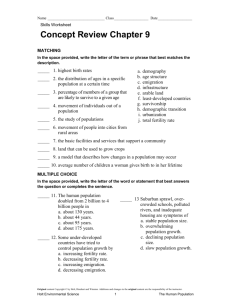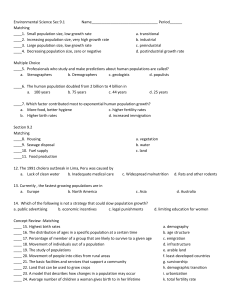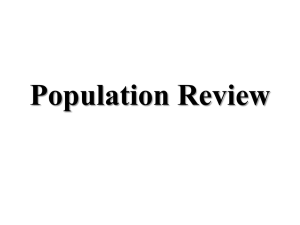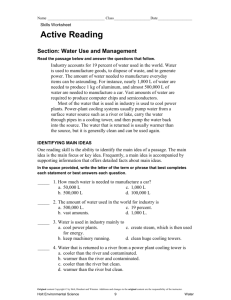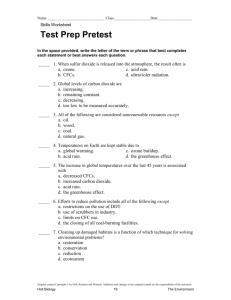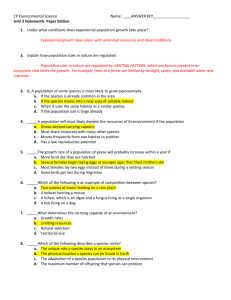Concept Review - Glynn County Schools
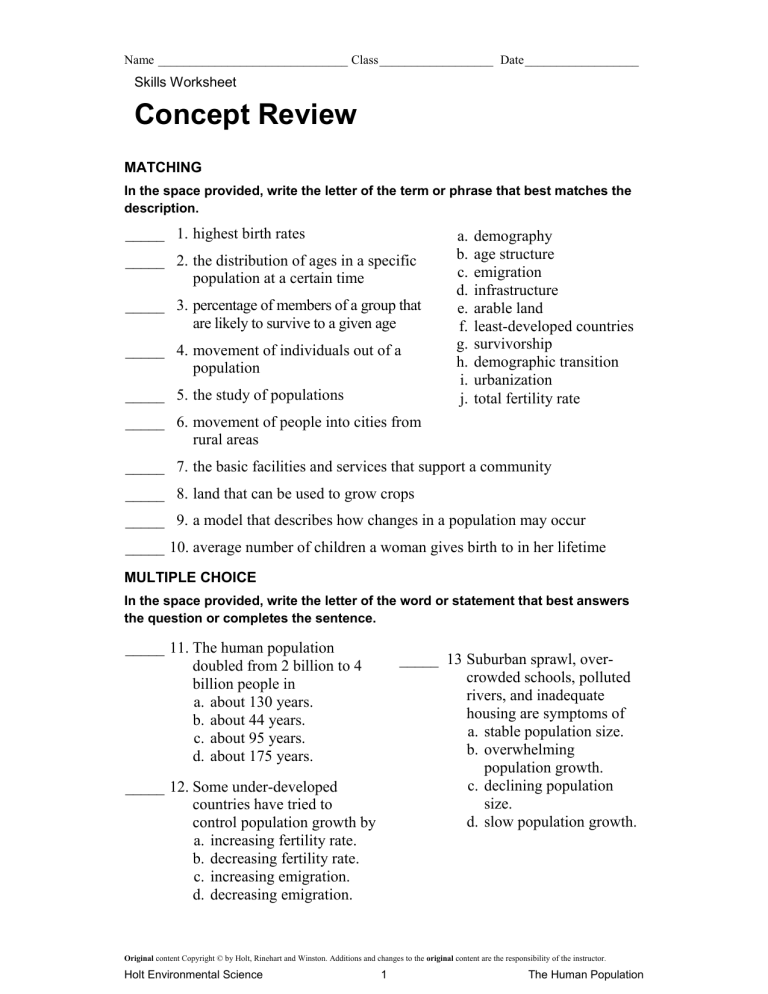
Name ______________________________ Class __________________ Date __________________
Skills Worksheet
Concept Review
MATCHING
In the space provided, write the letter of the term or phrase that best matches the description.
_____ 1. highest birth rates
_____ 2. the distribution of ages in a specific population at a certain time
_____ 3. percentage of members of a group that are likely to survive to a given age
_____ 4. movement of individuals out of a population
_____ 5. the study of populations
_____ 6. movement of people into cities from rural areas
a. demography
b. age structure
c. emigration
d. infrastructure
e. arable land
f. least-developed countries
g. survivorship
h. demographic transition
i. urbanization
j. total fertility rate
_____ 7. the basic facilities and services that support a community
_____ 8. land that can be used to grow crops
_____ 9. a model that describes how changes in a population may occur
_____ 10. average number of children a woman gives birth to in her lifetime
MULTIPLE CHOICE
In the space provided, write the letter of the word or statement that best answers the question or completes the sentence.
_____ 11. The human population doubled from 2 billion to 4 billion people in
a. about 130 years.
b. about 44 years.
c. about 95 years.
d. about 175 years.
_____ 12. Some under-developed countries have tried to control population growth by
a. increasing fertility rate.
b. decreasing fertility rate.
c. increasing emigration.
d. decreasing emigration.
_____ 13 Suburban sprawl, overcrowded schools, polluted rivers, and inadequate housing are symptoms of
a. stable population size.
b. overwhelming population growth.
c. declining population size.
d. slow population growth.
Original content Copyright © by Holt, Rinehart and Winston. Additions and changes to the original content are the responsibility of the instructor.
Holt Environmental Science 1 The Human Population
Name ______________________________ Class __________________ Date __________________
Concept Review continued
_____ 14. Access to adequate food,
_____ 20. Infant mortality rates are least effected by clean water, and safe sewage disposal have
a. average income.
b. parents’ access to resulted in a decline in
a. life expectancy. education.
c. clean water.
b. the birth rate.
c. the death rate.
d. adequate food.
d. infant health.
_____ 21. Life expectancy in sub-
Saharan Africa has
_____ 15. According to the theory of demographic transition, declined due to the epidemic of populations in Stage 1 tend to
a. tuberculosis.
b. AIDS.
a. increase.
b. decrease.
c. influenza.
d. bubonic plague.
c. remain the same.
d. be large.
_____ 16. Suburban sprawl results in
_____ 22. A population will shrink if deaths + emigrants exceeds
a. traffic jams.
b. inadequate infrastructure.
c. reduction of land for
a. deaths + births.
b. immigration emigration.
farms, ranches, and wildlife habitat.
c. births + immigrants.
d. the carrying capacity of
d. All of the above a nation.
_____ 17. A population’s age structure is represented by a
a. population pyramid.
b. survivorship curve.
c. total fertility rate.
d. migration rate.
_____ 23. Which of the following is not part of a community’s infrastructure?
a. public water supply
b. power plants
c. sewer lines
d. arable land
_____ 18. What is the main source of energy in the poorest countries?
a. coal
b. solar collectors
c. wood
d. nuclear reactors
_____ 24. The movement of individuals between areas is called
a. migration.
b. life expectancy.
c. survivorship.
d. urbanization.
_____ 19. The graph of human population growth since
1200 BCE looks like
a. a J-curve.
b. an S-curve.
c. a horizontal line.
d. a straight 45° line.
Original content Copyright © by Holt, Rinehart and Winston. Additions and changes to the original content are the responsibility of the instructor.
Holt Environmental Science 2 The Human Population
TEACHER RESOURCE PAGE
Answer Key
Concept Review
MATCHING
1. f
2. b
3. g
4. c
5. a
Critical Thinking
6. i
7. d
8. e
9. h
10. j
MULTIPLE CHOICE
11. b 18. c
12. b
13. b
14. c
15. c
16. d
17. a
19. a
20. a
21. b
22. c
23. d
24. a
ANALOGIES
1. c
2. b
3. d
4. b
5. c
6. b
7. b
INTERPRETING OBSERVATIONS
8. Educated women are more likely to have children that survive, have greater access to family planning techniques, and are more likely to contribute to the family income while spending less time bearing and raising children.
9. As infant mortality drops, there may be more births than deaths and the population will increase rapidly. However, families where the children are more likely to survive begin having fewer children. Eventually, the total fertility rate begins to drop, and over time, the total population drops.
10. Answers may vary. Sample answers may include: building more schools, training teachers or providing teachers from other countries, and giving incentives for sending children to school.
AGREE OR DISAGREE
11. Accept any thoughtful answer. Sample answer: Disagree; While many of the dayto-day population problems are felt most keenly by developing countries, the problems ultimately affect all countries, and most countries contribute to these problems as well. Developed countries do not usually have surging populations, but they do consume a much larger share of the world’s resources than do developing countries. Developing countries tend to face the more obvious problems associated with population growth, including air and water pollution, overcrowding, high infant mortality, and problems with food distribution.
12. Accept any thoughtful answer. Sample answer: Agree; Although life expectancy is rising in less developed regions due to lower infant mortality rates, life expectancy in more developed regions also continues to increase due to medical advances.
13. Accept any thoughtful answer. Sample answer: Disagree. A high degree of industrialization and development is not a requirement for urbanization.
Urbanization can occur anywhere that population is concentrating in cities, often after migration from rural areas. These cities need not be supported by modern infrastructure and can in fact be manifestations of unmanaged growth.
REFINING CONCEPTS
14. During Stage 1 of the demographic transition, both birth and death rates are high, and the population grows slowly—if at all. Therefore, the population is stable.
In Stage 3, population growth is also stable, but that is because the birth rate has now fallen equal to the now-low death rate. Thus, the two stages are similar in that birth and death rates roughly cancel each other out in both stages. Stages 1 and
3 differ in that birth and death rates are both high in Stage 1, while they are both low in Stage 3.
15. If a population grows too rapidly, it will use resources faster than the environ-
Original content Copyright © by Holt, Rinehart and Winston. Additions and changes to the original content are the responsibility of the instructor.
Holt Environmental Science 86 The Human Population
